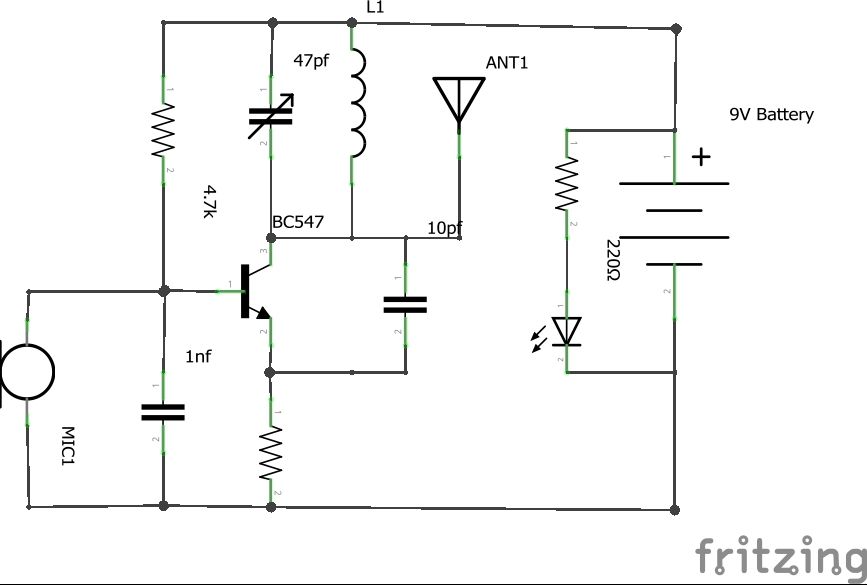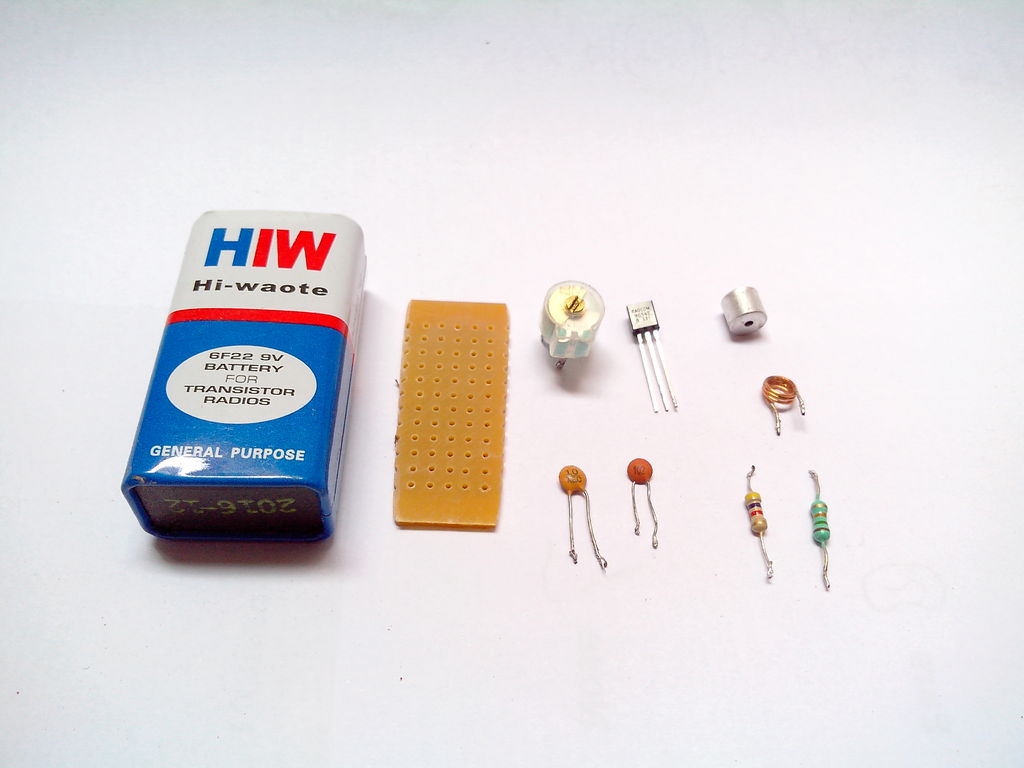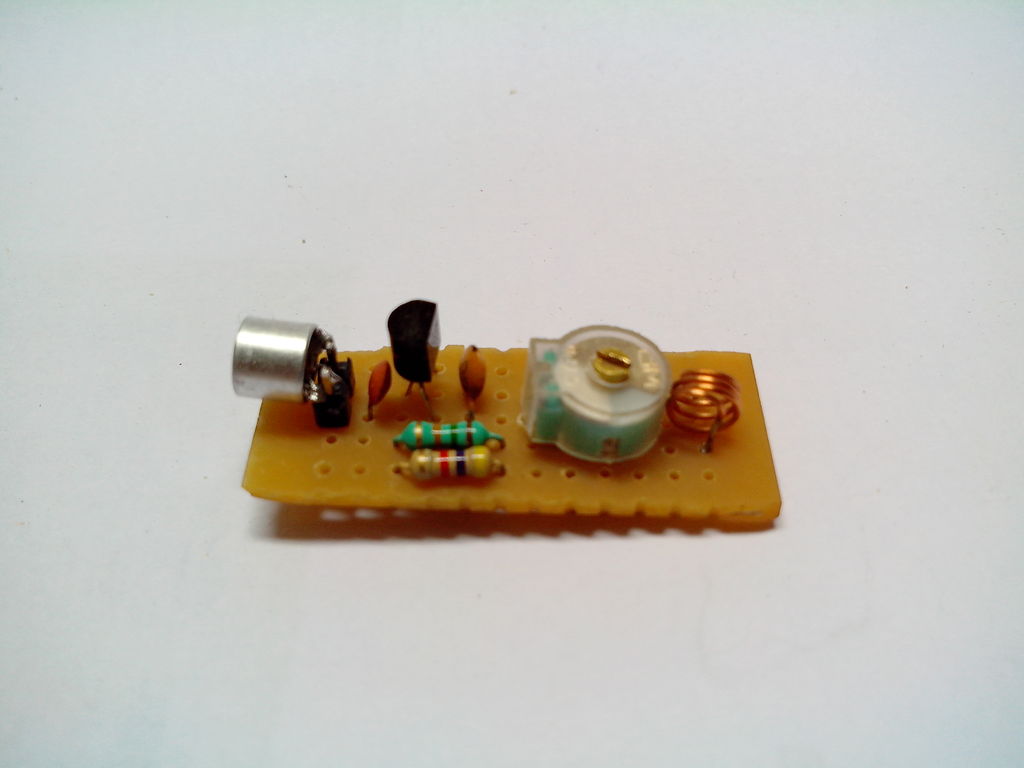| |
Here's how to build your own mini FM transmitter. It transmits FM waves so you could easily receive the signals on your mobile phone, radios, etc. As the name and the picture indicates it is very small and is approximately the size of a 9v battery clip. With this FM transmitter you could start your own mini FM station. The circuit uses BC547 transistor to amplify the signal and then frequency modulate it. It uses "frequency modulation" most commonly known as FM, the same principal to transmit audio signals captured by the microphone.

Lets start with getting all the parts.
Components
BC547 Transistor
An microphone
A variable capacitor 47pf
An Inductor (see steps for description)
4.7k Resistor
330ohm resistor
1n capacitor (102)
10p capacitor
9V battery
LED(optional)
Tools
Soldering Iron
An FM receiver (any mobile phone)
I got almost all of the components from a pile of old PCBs I had in an old forgotten box. All I had to get was the BC547 and the electret microphone. Actually I did find the BC547 in an old PCB but i was not sure if it would work. It looked quite burnt to me. The old PCBs had many components resistors, crystals, diodes, etc. I may use them some day and for know back in the box.
I had to de-solder the parts of the old board, for those who don't know how to solder and de-solder there is a bunch of instructables that describe how to do this and learning to solder is not a hard task.
First of all lets start with cutting up a PCB to the required size. The size to compare is a 9v battery clip, it might look quite small in the beginning but don't worry it would hold all the components just fine. Use a sand paper for smoothing the sides of the PCB and to clear out any rough edges.
Make sure to get a PCB with big holes as the variable capacitor pins won't go in the standard size holes.
You can get the microphone at a local hardware store. And be sure to get some male pins to hold the microphone in place refer the picture as to how to solder the microphone in place.
Why not use some wires to hold the microphone?
I would not suggest wires as when you tape the circuit if the last few steps you would not get a clear audio. I tried it and got a lot of noise. I got lesser noise when I used the male pins soldered to the microphone.
Once you're done with the PCB and know where and how to solder the microphone now it's time to complete the rest of the circuit. Follow the circuit above and solder all of the components. Make sure not to leave any space between any of the components if you need to get the circuit small. For the inductor use 0.5mm wire and 8 turns, with each turn with a diameter of 6mm.
And for the antenna just use a thin 5cm long wire. For more stability you could center tap the coil and solder the antenna to the center tap.
Also If you notice the circuit has a LED in it, it is used to show when the circuit is functional. I did not add the LED in my circuit because it was draining my battery faster.
Once you got the circuit like the one in the above picture, it's time to cover it with tape. I used wiring tape to cover the whole circuit except the microphone and the variable capacitor. This is an important step as when you proceed to the next step, where you tune to the required bandwidth. Touching the circuit (mainly the coil) with your fingers would lead to severe noise.
You could also use a heat sink instead of tape, I used tape because I wanted to experiment withe circuit so I did not want it to be permanent.
Now it's time to tune the circuit to a required bandwidth, you could do this in two ways.
Use your mobile phone to find the signal
Manually tune the variable capacitor to match a frequency
The first step is recommended all you have to do is power the circuit and turn on auto find bands on your mobile. Your mobile would scan for channels and all you have to do is look for your transmitter (play some music in front of the transmitter) on that list.
The second method is time consuming, in this method you have to turn on your radio and the circuit. Keep the radio at a specific channel, and then tune the variable capacitor extremely slowly. When you hear stuff on the radio maybe a song that you are playing stop and the bandwidth on the radio is the required bandwidth.
After using the 9v battery circuit for some time I thought of replacing the battery with rechargeable Li-ion batteries. If you have viewed my previous instructables you would have seen that I use these batteries a lot.
The rechargeable batteries provide longer transmission than the common 9v battery.



Related Links
Downloads
Mini FM Transmitter - Link
|
|
|
| |
Accurate LC Meter
Build your own Accurate LC Meter (Capacitance Inductance Meter) and start making your own coils and inductors. This LC Meter allows to measure incredibly small inductances making it perfect tool for making all types of RF coils and inductors. LC Meter can measure inductances starting from 10nH - 1000nH, 1uH - 1000uH, 1mH - 100mH and capacitances from 0.1pF up to 900nF. The circuit includes an auto ranging as well as reset switch and produces very accurate and stable readings. |
|
PIC Volt Ampere Meter
Volt Ampere Meter measures voltage of 0-70V or 0-500V with 100mV resolution and current consumption 0-10A or more with 10mA resolution. The meter is a perfect addition to any power supply, battery chargers and other electronic projects where voltage and current must be monitored. The meter uses PIC16F876A microcontroller with 16x2 backlighted LCD. |
|
|
|
60MHz Frequency Meter / Counter
Frequency Meter / Counter measures frequency from 10Hz to 60MHz with 10Hz resolution. It is a very useful bench test equipment for testing and finding out the frequency of various devices with unknown frequency such as oscillators, radio receivers, transmitters, function generators, crystals, etc. |
|
1Hz - 2MHz XR2206 Function Generator
1Hz - 2MHz XR2206 Function Generator produces high quality sine, square and triangle waveforms of high-stability and accuracy. The output waveforms can be both amplitude and frequency modulated. Output of 1Hz - 2MHz XR2206 Function Generator can be connected directly to 60MHz Counter for setting precise frequency output. |
|
|
|
BA1404 HI-FI Stereo FM Transmitter
Be "On Air" with your own radio station! BA1404 HI-FI Stereo FM Transmitter broadcasts high quality stereo signal in 88MHz - 108MHz FM band. It can be connected to any type of stereo audio source such as iPod, Computer, Laptop, CD Player, Walkman, Television, Satellite Receiver, Tape Deck or other stereo system to transmit stereo sound with excellent clarity throughout your home, office, yard or camp ground. |
|
USB IO Board
USB IO Board is a tiny spectacular little development board / parallel port replacement featuring PIC18F2455/PIC18F2550 microcontroller. USB IO Board is compatible with Windows / Mac OSX / Linux computers. When attached to Windows IO board will show up as RS232 COM port. You can control 16 individual microcontroller I/O pins by sending simple serial commands. USB IO Board is self-powered by USB port and can provide up to 500mA for electronic projects. USB IO Board is breadboard compatible. |
|
|
|
|
ESR Meter / Capacitance / Inductance / Transistor Tester Kit
ESR Meter kit is an amazing multimeter that measures ESR values, capacitance (100pF - 20,000uF), inductance, resistance (0.1 Ohm - 20 MOhm), tests many different types of transistors such as NPN, PNP, FETs, MOSFETs, Thyristors, SCRs, Triacs and many types of diodes. It also analyzes transistor's characteristics such as voltage and gain. It is an irreplaceable tool for troubleshooting and repairing electronic equipment by determining performance and health of electrolytic capacitors. Unlike other ESR Meters that only measure ESR value this one measures capacitor's ESR value as well as its capacitance all at the same time. |
|
Audiophile Headphone Amplifier Kit
Audiophile headphone amplifier kit includes high quality audio grade components such as Burr Brown OPA2134 opamp, ALPS volume control potentiometer, Ti TLE2426 rail splitter, Ultra-Low ESR 220uF/25V Panasonic FM filtering capacitors, High quality WIMA input and decoupling capacitors and Vishay Dale resistors. 8-DIP machined IC socket allows to swap OPA2134 with many other dual opamp chips such as OPA2132, OPA2227, OPA2228, dual OPA132, OPA627, etc. Headphone amplifier is small enough to fit in Altoids tin box, and thanks to low power consumption may be supplied from a single 9V battery. |
|
|
|
|
|
Arduino Prototype Kit
Arduino Prototype is a spectacular development board fully compatible with Arduino Pro. It's breadboard compatible so it can be plugged into a breadboard for quick prototyping, and it has VCC & GND power pins available on both sides of PCB. It's small, power efficient, yet customizable through onboard 2 x 7 perfboard that can be used for connecting various sensors and connectors. Arduino Prototype uses all standard through-hole components for easy construction, two of which are hidden underneath IC socket. Board features 28-PIN DIP IC socket, user replaceable ATmega328 microcontroller flashed with Arduino bootloader, 16MHz crystal resonator and a reset switch. It has 14 digital input/output pins (0-13) of which 6 can be used as PWM outputs and 6 analog inputs (A0-A5). Arduino sketches are uploaded through any USB-Serial adapter connected to 6-PIN ICSP female header. Board is supplied by 2-5V voltage and may be powered by a battery such as Lithium Ion cell, two AA cells, external power supply or USB power adapter. |
|
200m 4-Channel 433MHz Wireless RF Remote Control
Having the ability to control various appliances inside or outside of your house wirelessly is a huge convenience, and can make your life much easier and fun. RF remote control provides long range of up to 200m / 650ft and can find many uses for controlling different devices, and it works even through the walls. You can control lights, fans, AC system, computer, printer, amplifier, robots, garage door, security systems, motor-driven curtains, motorized window blinds, door locks, sprinklers, motorized projection screens and anything else you can think of. |
|
|
|